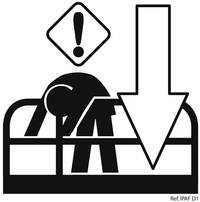Access Platform Emergencies
Have you got one of these symbols below in case of access platform emergencies?
Access platform emergencies require a quick, trained response to prevent serious injury to personnel. Access platforms need clearly signposted emergency controls and an Emergency Plan in operation. These are available from the IPAF website.
“Even experienced operators sometimes have difficulty locating the emergency descent controls that every mobile elevating work platform is fitted with,” said Tim Whiteman, IPAF managing director. “This new symbol is a practical visual aid and a prime example of an industry initiative to make access equipment even safer. We encourage manufacturers to fit this as standard on new equipment and rental companies to fit this decal to their existing fleets.”
Clearly signposted emergency controls and a well trained and familiarised workforce will mitigate against most access platform emergencies. Quickly finding the emergency descent symbol, staying calm and using the inbuilt safety systems saves lives. As required by UK law all access platform operatives should be fully trained, whether they are working at height or on the ground. Promax Access offer a comprehensive training programme and help with your company Emergency Plan.
The Emergency Plan is an essential part of the Risk Assessment carried out before working at height is undertaken. It details various emergency situations and the proposed action to be taken.
Common Access Platform Emergencies
Failure of upper control functions while elevated:
Proposed action:
– operator will use the upper auxiliary controls
Failure of the operator to be able to operate the MEWP functions while elevated due to one of the following reasons:
– Operator incapacitated
– Auxiliary functions fail to operate from upper control station
Proposed action:
Where the operator is incapable of lowering the raised platform using the upper controls, an appointed person familiarised in the use of the ‘ground’ controls will lower the platform safely using the normal ground controls [name of nominated, trained and authorised ground person onsite]
Failure of normal ground controls:
Proposed action:
Where the normal ground controls fail, an appointed person familiarised in the use of the ‘ground’ controls will use the ground auxiliary controls to safely lower the platform [name of nominated, trained and authorised ground person onsite]
Failure of ALL normal and auxiliary lowering functions:
Proposed action:
Where all normal and auxiliary functions have failed, a competent and authorised service engineer should be contacted [name and contact number]
Consideration for mid-air rescue:
A mid-air, platform to platform rescue should only be considered in exceptional circumstances and only after:
• Site management have contacted the competent and authorised service engineer listed in the rescue plan, to report failure of normal and auxiliary lowering systems and request engineering assistance.
If after inspection by the competent engineering assistance, it is not possible to effect a timely repair to allow the machine to be brought to the ground safely, senior site management should be contacted for permission to carry out mid-air rescue.
OR
Where the competent engineering assistance is not readily available and an immediate risk exists to the health and safety of any of the occupants from remaining in the elevated basket until an engineer can attend, then senior site management should be contacted for permission to carry out mid-air rescue.
Code of practice for mid-air rescue
A. Rescue using another MEWP should only be performed once a site-specific risk assessment has been carried out and a specific access platform emergencies plan has been documented and approved by senior management.
B. The rescue machine must be positioned so as to enable the rescue procedure to be carried out without compromising the safety of any personnel involved in the rescue procedure.
C. The platforms of both machines must be adjacent to each other with a minimal gap between them, unless exceptional circumstances mean this is not possible.(Where this is not possible, the circumstances shall be recorded onto the risk assessment form.)
D. Where reasonably practicable, precautions should be taken to prevent inadvertent movement of both platforms during the transfer.
E. The person being rescued (transferred from basket to basket) should wear a full body harness with an adjustable lanyard – the lanyard should be attached to the anchor point on the rescue machine before transfer takes place.
F. Care must be taken not to overload the rescue machine during transfer. This may mean making more than one journey to complete the rescue.
Further guidance on mid-air rescue can be found in ISO 18893:2014 – 6.1.2.8.
Whatever the operating scenario, it is vital that the access equipment is in full working order following pre-start checks and that all operators are familiarised with the specific make and model being used and its safety controls.
